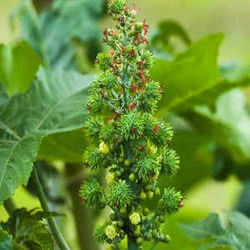- Description
Castor bean is a herbacious annual which can reach to nearly 15 feet tall when growing in open spaces in warm climates. Large leaves are alternate, palmately lobed with 5-11 toothed lobes. Leaves are glossy and often red or bronze tinted when young. Flowers appear in clusters at the end of the main stem in late summer. The fruit consists of an oblong spiny pod which contains three seeds on average. Seeds are oval and light brown, mottled or streaked with light and dark brown and resemble a pinto bean. The plant itself is fast growing, but the seeds require a long frost-free season in order to mature.
- Conditions of poisoning
All parts of the plants are toxic, but most dangerous are the seeds. The most susceptible animal species include cattle, horses, sheep, pigs, fowl, rabbits and other small animals. Seeds ingested at 0.2% of body weight have caused toxicosis in cattle and 0.01% of body weight was toxic to horses.
- Toxic principle
The principle toxin of castor bean is ricin which is a lectin, also termed a toxalbumin. Ricin may comprise up to 3% of the seed weight. Toxalbumins are very toxic plant-derived compounds that combine carbohydrate and protein moieties or components. Ricin is water soluble and is not present in castor oil. Taken orally, ricin is readily absorbed from the stomach and intestine. Another phytotoxin in castor bean, ricinine, is reportedly goitrogenic, but the significance of this compound is not clearly established.

